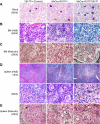Conditional expression of heterozygous or homozygous Jak2V617F from its endogenous promoter induces a polycythemia vera-like disease
- PMID: 20197548
- PMCID: PMC2867267
- DOI: 10.1182/blood-2009-04-215848
Conditional expression of heterozygous or homozygous Jak2V617F from its endogenous promoter induces a polycythemia vera-like disease
Abstract
A somatic point mutation (V617F) in the JAK2 tyrosine kinase was found in a majority of patients with polycythemia vera (PV), essential thrombocythemia, and primary myelofibrosis. However, contribution of the JAK2V617F mutation in these 3 clinically distinct myeloproliferative neoplasms (MPNs) remained unclear. To investigate the role of JAK2V617F in the pathogenesis of these MPNs, we generated an inducible Jak2V617F knock-in mouse, in which the expression of Jak2V617F is under control of the endogenous Jak2 promoter. Expression of heterozygous mouse Jak2V617F evoked all major features of human polycythemia vera (PV), which included marked increase in hemoglobin and hematocrit, increased red blood cells, leukocytosis, thrombocytosis, splenomegaly, reduced serum erythropoietin (Epo) levels and Epo-independent erythroid colonies. Homozygous Jak2V617F expression also resulted in a PV-like disease associated with significantly greater reticulocytosis, leukocytosis, neutrophilia and thrombocytosis, marked expansion of erythroid progenitors and Epo-independent erythroid colonies, larger spleen size, and accelerated bone marrow fibrosis compared with heterozygous Jak2V617F expression. Biochemical analyses revealed Jak2V617F gene dosage-dependent activation of Stat5, Akt, and Erk signaling pathways. Our conditional Jak2V617F knock-in mice provide an excellent model that can be used to further understand the molecular pathogenesis of MPNs and to identify additional genetic events that cooperate with Jak2V617F in different MPNs.
Figures






Similar articles
-
Critical requirement for Stat5 in a mouse model of polycythemia vera.Blood. 2012 Apr 12;119(15):3539-49. doi: 10.1182/blood-2011-03-345215. Epub 2011 Dec 5. Blood. 2012. PMID: 22144185 Free PMC article.
-
Molecular pathogenesis and therapy of polycythemia induced in mice by JAK2 V617F.PLoS One. 2006 Dec 20;1(1):e18. doi: 10.1371/journal.pone.0000018. PLoS One. 2006. PMID: 17183644 Free PMC article.
-
Expression of Jak2V617F causes a polycythemia vera-like disease with associated myelofibrosis in a murine bone marrow transplant model.Blood. 2006 Jun 1;107(11):4274-81. doi: 10.1182/blood-2005-12-4824. Epub 2006 Feb 14. Blood. 2006. PMID: 16478879 Free PMC article.
-
Current diagnostic criteria for the chronic myeloproliferative disorders (MPD) essential thrombocythemia (ET), polycythemia vera (PV) and chronic idiopathic myelofibrosis (CIMF).Pathol Biol (Paris). 2007 Mar;55(2):92-104. doi: 10.1016/j.patbio.2006.06.002. Epub 2006 Aug 21. Pathol Biol (Paris). 2007. PMID: 16919893 Review.
-
Polycythemia vera: scientific advances and current practice.Semin Hematol. 2005 Oct;42(4):206-20. doi: 10.1053/j.seminhematol.2005.08.003. Semin Hematol. 2005. PMID: 16210034 Review.
Cited by
-
Molecular Pathogenesis and Clinical Significance of Driver Mutations in Primary Myelofibrosis: A Review.Med Princ Pract. 2016;25(6):501-509. doi: 10.1159/000450956. Epub 2016 Sep 21. Med Princ Pract. 2016. PMID: 27756071 Free PMC article. Review.
-
Myeloproliferative neoplasm animal models.Hematol Oncol Clin North Am. 2012 Oct;26(5):1065-81. doi: 10.1016/j.hoc.2012.07.007. Epub 2012 Aug 21. Hematol Oncol Clin North Am. 2012. PMID: 23009938 Free PMC article. Review.
-
Normal and dysregulated crosstalk between iron metabolism and erythropoiesis.Elife. 2023 Aug 14;12:e90189. doi: 10.7554/eLife.90189. Elife. 2023. PMID: 37578340 Free PMC article.
-
JAK2 inhibitors: what's the true therapeutic potential?Blood Rev. 2011 Mar;25(2):53-63. doi: 10.1016/j.blre.2010.10.004. Epub 2010 Nov 20. Blood Rev. 2011. PMID: 21095048 Free PMC article. Review.
-
Combination of PIM and JAK2 inhibitors synergistically suppresses MPN cell proliferation and overcomes drug resistance.Oncotarget. 2014 May 30;5(10):3362-74. doi: 10.18632/oncotarget.1951. Oncotarget. 2014. PMID: 24830942 Free PMC article.
References
-
- James C, Ugo V, Le Couedic JP, et al. A unique clonal JAK2 mutation leading to constitutive signaling causes polycythemia vera. Nature. 2005;434(7037):1144–1148. - PubMed
-
- Levine RL, Wadleigh M, Cools J, et al. Activating mutation in the tyrosine kinase JAK2 in polycythemia vera, essential thrombocythemia, and myeloid metaplasia with myelofibrosis. Cancer Cell. 2005;7(4):387–397. - PubMed
-
- Baxter EJ, Scott LM, Campbell PJ, et al. Acquired mutation of the tyrosine kinase JAK2 in human myeloproliferative disorders. Lancet. 2005;365(9464):1054–1061. - PubMed
-
- Kralovics R, Passamonti F, Buser AS, et al. A gain-of-function mutation of JAK2 in myeloproliferative disorders. N Engl J Med. 2005;352(17):1779–1790. - PubMed
Publication types
MeSH terms
Substances
Grants and funding
LinkOut - more resources
Full Text Sources
Other Literature Sources
Molecular Biology Databases
Research Materials
Miscellaneous

